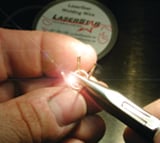Laser Welding vs. Soldering
There are many different reasons why laser welding jewelry is superior to soldering jewelry. To better understand the differences, we must first look closely at the two processes. Soldering, or more appropriately brazing, is a capillary fill system where solder is heated with a gas-oxygen torch or open flame. The solder then flows across and bridges the noble metals together. Solder is an alloy that is designed to melt at a lower temperature than the noble metal one is soldering. Therefore, it is a different alloy than the noble metal. The heat used for this process is very high, and thus often results in a visible seam, discoloration or fire scale in the solder area.
L aser welding is a process in which light energy is used to weld the noble metals to themselves; this process fuses the noble metal on a molecular level resulting in a finished product that is all one alloy. When adding metal or “laser filler wire” with the laser welder, we will almost always add the same noble alloy. The heat used in the laser welding process is so localized that it results in a seamless, undetectable work zone that is not discolored in any way.
aser welding is a process in which light energy is used to weld the noble metals to themselves; this process fuses the noble metal on a molecular level resulting in a finished product that is all one alloy. When adding metal or “laser filler wire” with the laser welder, we will almost always add the same noble alloy. The heat used in the laser welding process is so localized that it results in a seamless, undetectable work zone that is not discolored in any way.
When soldering with a torch, the heat is applied to a relatively large area resulting in heat transfer. If the user is not careful, he can burn or destroy heat sensitive stones and other heat sensitive materials that are in close proximity to the flame. The jeweler is forced to either remove these stones or protect these areas with a heat absorbing substance.
The laser has a finely focused laser beam resulting in a minimal heat-affected zone or "bombardment zone." During the laser welding process, the metal adjacent to the bombardment zone does not become molten. This precision heat source allows the user to laser weld metal in close proximity of heat sensitive stones and materials such as epoxy, enamel, pearls and stringing thread to name a few, without affecting the stone or material. Because of this pinpoint heat source, the laser weld will not anneal springs or clips eliminating the need to replace damaged findings.
When soldering, steps must be taken prior to and after the heating process. One step is to thoroughly clean the jewelry of any dirt or oils from its surface. To reduce the amount of fire scale; the user must also coat the jewelry with a mixture of boric acid and denatured alcohol prior to soldering. This mixture must later be removed by pickling.
- Ring resizing, retipping prongs, repairing bezel settings
- Reassembly of broken necklaces, bracelts and earrings
- Repairing costume jewelry, eyeglass frames and watch bands
- Filling porosity and creating made-to-order designs
A good laser weld is three times as strong as the virgin metal, or 260 times stronger than a solder joint. To learn more about laser welding jewelry, please contact us today. We would be happy to answer any of your questions.


